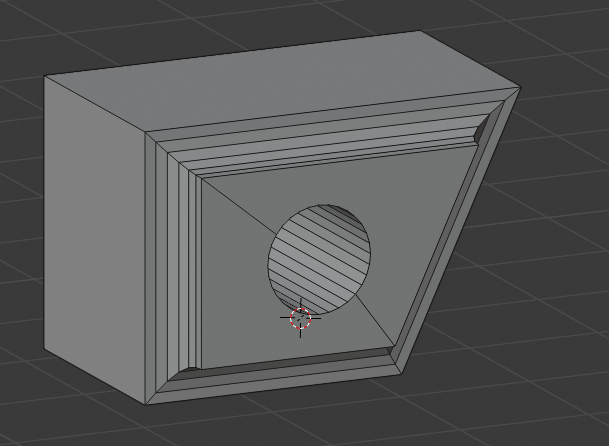面中的孔洞
This section will look at some alternative ways of dealing with holes in surface. In Blender, holes are generally dealt with by using boolean modifiers, or boolean operations in Edit mode. These result in many quad, or tri faces on what is essentially a flat surface. CAD Designers would traditionally want a flat complex face to be an Ngon, since Sub-Division modifiers would not be used for this type of modeling.
Alternative methods include using 2D curve surface, where any internal faces are treated as holes. The disadvantage of this system is that to include these in a vertex mesh they must first be converted to meshes, resulting in many tris on the flat face, again causing problems because these cannot be beveled.
PDT的方法来打洞:
在PDT中,我们采用了一种新的方法,即把正面切割成尽可能少的多边面,以容纳孔。这仍然不理想,目前正在提倡另外两种选择:
允许在面中开孔,就像在2D曲面和CAD软件中一样。
引入
混合对象,可以容纳2D曲面和顶点网格。
允许有孔意味着某些功能,如雕刻将无法实现,所以这种类型的面将被排除在这种功能之外。

你可以从前面看到孔所在的面被拆成了两个面。
过程是删除现有的正面,把孔画成一个圆柱体,然后用 PDT连接2点 功能在外边缘和孔之间做连接边,然后通过选择边缘和使用Blender创建面(热键F)命令创建2个面。
下面是一个2D曲面的例子,所显示的设置是使其成为一个填充曲面。

这些曲线面可以被放置在网格对象的前面以形成一个面,但这需要在尴尬的旋转角度中使用对齐工具,这一点我们还没有发布。这方面的限制条件是,你永远不能 应用 所使用的旋转,但这并不困难。
Below is what this looks like if converted to a mesh, producing totally unsuitable topology for precision modeling, or even beveling:

这个对象有146个面,却只用了3条曲线定义了这个2D曲面。
这里是另一个使用PDT技术的孔状表面的例子。

数数面数! - 49个洞,前面有3个面,后面有3个。